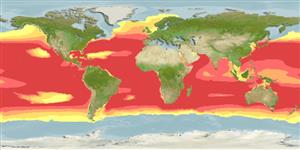Common names from other countries
Environment: milieu / climate zone / depth range / distribution range
Ecologia
marinhas batipelágico; oceanódromo (Ref. 51243); intervalo de profundidade 0 - 1050 m (Ref. 44036). Deep-water
Eastern Atlantic: Morocco to Namibia (gap over region of cyclonic gyre 4°-6°S). Western Atlantic: USA to Subtropical Convergence, [but absent over minimum region off Brazil according to Ref. 4479] and lower abundance in Sargasso Sea. Also in the southern Indian Ocean, North and South Pacific (absent in equatorial waters). South China Sea (Ref.74511).
Comprimento de primeira maturação / Tamanho / Peso / Idade
Maturity: Lm ?, range 5 - ? cm
Max length : 6.0 cm SL macho/indeterminado; (Ref. 4479)
Espinhos dorsais (total) : 0; Raios dorsais (total) : 13 - 15; Espinhos anais: 0; Raios anais : 21 - 25; Vértebras: 38 - 40. Branchiostegal rays: 8-9 (Ref. 31442). Anal organs 14-15; males with single supracaudal gland filling about 1/2 the supracaudal space, females with 3 coalesced infracaudal gland patches, sometimes separate (Ref. 39633).
Oceanic, found below 1,000 m during the day and from the surface to 200 m at night (Ref. 4479). Neustonic to mesopelagic (Ref. 58302). Oviparous, with planktonic eggs and larvae (Ref. 31442). Lipid content is 3.3 % in fresh body weight and wax ester is 10 % in total lipids (Ref. 9197). Reach sexual maturity at 4,6 cm (Ref. 47377).
Ciclo de vida ou comportamento de acasalamento
Maturities | Reprodução | Spawnings | Egg(s) | Fecundities | Larvas
Hulley, P.A., 1990. Myctophidae. p. 398-467. In J.C. Quero, J.C. Hureau, C. Karrer, A. Post and L. Saldanha (eds.) Check-list of the fishes of the eastern tropical Atlantic (CLOFETA). JNICT, Lisbon; SEI; Paris; and UNESCO, Paris. Vol. 1. (Ref. 4479)
Status na Lista Vermelha da UICN (Ref. 130435)
CITES (Ref. 128078)
Not Evaluated
Ameaça para os humanos
Harmless
Uso pelos humanos
Ferramentas
Relatórios especiais
Baixar XML
Fontes da internet
Estimates based on models
Preferred temperature (Ref.
115969): 8.6 - 20.6, mean 13.7 (based on 1088 cells).
Índice de diversidade filogenética (Ref.
82804): PD
50 = 0.5020 [Uniqueness, from 0.5 = low to 2.0 = high].
Bayesian length-weight: a=0.00692 (0.00297 - 0.01609), b=3.13 (2.93 - 3.33), in cm Total Length, based on LWR estimates for this (Sub)family-body shape (Ref.
93245).
Nível Trófico (Ref.
69278): 3.2 ±0.31 se; based on food items.
Resiliência (Ref.
120179): Elevada, tempo mínimo de duplicação da população menor que 15 meses (Preliminary K or Fecundity.).
Fishing Vulnerability (Ref.
59153): Low vulnerability (10 of 100).
